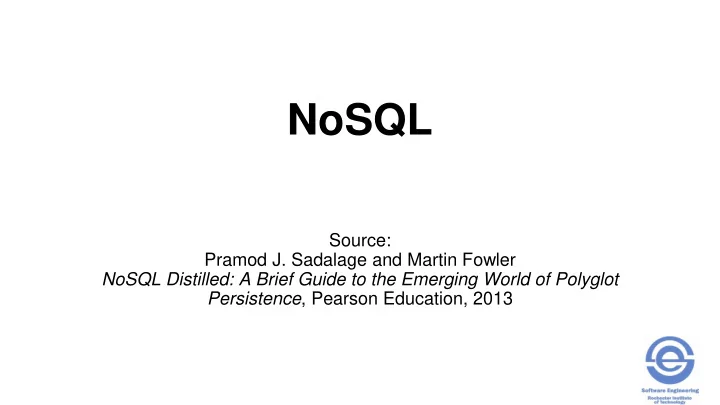

NoSQL Source: Pramod J. Sadalage and Martin Fowler NoSQL Distilled: A Brief Guide to the Emerging World of Polyglot Persistence , Pearson Education, 2013
Objectives Introduce some key concepts behind the NoSQL family of databases Why NoSQL? Why relational databases? Impedance mismatch – relational models are limiting Application and integration databases Distributed database clusters Introduce aggregate data models Key-Value data models Document data models Column-family store data models
Why NoSQL?
Why Relational Databases? ∙ For decades, relational databases have been the default choice for serious data storage − Persistence : provide a “backing” store for volatile memory ▪ More flexible than a file system for storing large amounts of memory and accessing it in small bits − Concurrency : multiple applications accessing shared data ▪ Transactions − Integration : multiple applications store their data in a single database − Standard : developers and database professionals can easily move between projects and technologies
Impedance Mismatch ∙ Impedance Mismatch: the difference between the relational model and the in-memory data structures − Relational model: everything is a relation – tables of rows − Structure and relationships have to be mapped ▪ Rich, in-memory structures have to be translated to relational representation to be stored on disk ▪ Translation: impedance mismatch
Impedance Mismatch
Impedance Mismatch (cont.) ∙ Object-oriented programming languages became popular in 1990s, but object-oriented databases did not ∙ Entrenched relational database vendors − Database as an integration mechanism − Standard data manipulation language (SQL) − Professional divide between application developers and database administrators − Object-relational mapping frameworks ease the grunt work ▪ But often result in serious performance issues
Application and Integration Databases ∙ Integration databases are a convenient and powerful method for integrating multiple applications developed by different teams − Common data model, common data store ∙ Integrate many applications becomes (dramatically) more complex than any single application needs − Changes to the data model must be coordinated − Different structural and performance needs for different applications − Database integrity becomes an issue ∙ Instead, treat the database as an application database − Single application, single development team − Provide alternate integration mechanisms
Alternate Integration Mechanism: Services ∙ More recent push to use Web Services where applications integrate over HTTP communications − XML-RPC, SOAP, REST ∙ Results in more flexibility for exchange data structure − XML, JSON, etc. − Text-based protocols ∙ Results in letting application developers choose database − Application databases − Relational databases are often still an appropriate choice
The Attack of the Clusters ∙ The 2000s saw the web grow enormously − Web use tracking data, social networks, activity logs, mapping data, etc. − Huge websites serving huge numbers of visitors ∙ To handle the increase in data and traffic required more computing resources ∙ Instead of building bigger machines with more processors, storage, and memory, use clusters of small, commodity machines − Cheaper, more resilient ∙ But relational databases are not designed to be run on clusters
Clustered Relational Databases ∙ Clustered relational databases such as Oracle Real Application Clusters (RAC) and Microsoft SQL Server still work against a single database disk subsystem − A cluster-aware file system and a highly-available disk subsystem − Disk subsystem is a single point of failure ∙ Can also partition the database into functionally distinct subsets (“ sharding ”) − Each application has to keep track of which database server to talk to for each bit of data − Lose cross-shard querying, referential integrity, transactions, or consistency control ∙ Commercial relational database licenses are typically per node, raising overall cost for clusters
“ sharding ” Size and Transaction Volume (linear growth): • CPU • Memory • Disk Response time (exponential growth) You cannot add an unlimited number of CPUs (or processing cores) and see a commensurate increase in performance without also improving the memory capacity and performance of the disk drive subsystem http://www.agildata.com/database-sharding/
“ sharding ” Advantages (smaller databases) : • Easier to manage • Faster • Reduce costs Disadvantages (challenges) : • Reliability (backups, redundancy, failover, disaster recovery) • Distributed queries (cross-shard joins) • Auto-increment key management • Multiple shard schemes (session/transaction or statement based sharding) http://www.agildata.com/database-sharding/
New Opportunities ∙ The mismatch between relational databases and clusters led some organizations to consider alternative approaches to data storage − Google and Amazon have been very influential ▪ Large clusters and huge amounts of data ▪ Google: BigTable paper; Amazon: Dynamo paper ∙ Few organizations need the scale of Google or Amazon, but many organizations are seeing an exponential increase in data storage and use ∙ New styles of databases explicitly designed to run on clusters
The Emergence of NoSQL ∙ Historical note: ‘NoSQL’ was first used to name an open -source relational database development led by Carlo Strozzi − Based on ASCII storage of tables manipulated through Unix shell scripts instead of SQL − No influence on databases under the current use of the term ‘NoSQL’ ∙ Current use of the phrase came from a conference meetup discussing “open -source, distributed, nonrelational databases” − Talks from Voldemort, Cassandra, Dynomite, HBase, Hypertable, CouchDB, MongoDB ∙ No generally accepted definition of ‘NoSQL’ − Often “Not only SQL”
Characteristics of NoSQL Databases ∙ They do not use SQL and the relational model − Some do have query languages which are similar to SQL to be easy to learn and use ∙ Mostly open-source projects ∙ Designed to be distributed – clustered − No expectation of ACID properties − Range of options for consistency and distribution ∙ Schema free − Freely add fields to records without having to define any changes in structure first − Non-uniform data and custom fields ∙ A noDefinition of NoSQL: An ill-defined set of mostly open-source databases, mostly developed in the early 21 st century, and mostly not using SQL
The DB world https://blogs.the451group.com/information_management/2011/04/15/nosql-newsql-and-beyond/
Polyglot Persistence (Fowler)
Polyglot Persistence (Fowler)
Recommend
More recommend